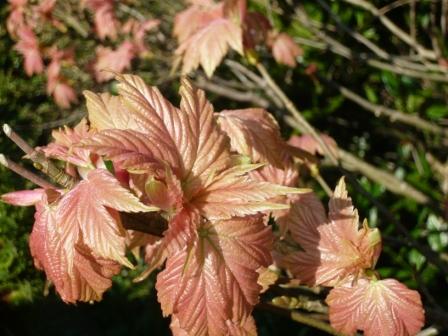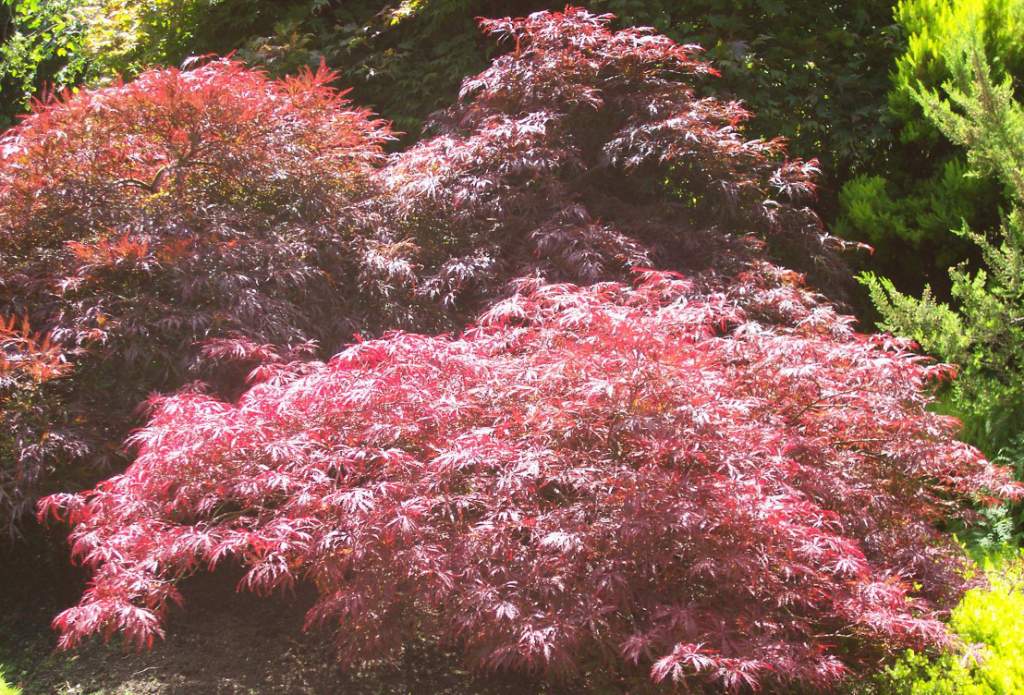Tips for Growing Acer – Japanese Maples
Acer trees and shrubs can be spectacular from Spring through Autumn due to the leaf colours and patterns. This Acer Palmatum Taylor’s leaves with pink foliage will last through summer turning into rich Autumn colours at the backend. It will grow to about 10 feet in 10 years and is suitable for even a small garden.
Top Low Growing Acers
- The cut leaf maple Acer Palmatum Dissectum is an umberella shaped shrub with unusually shaped fresh green leaves. The leaves develop a red stripe in the Autumn. The name gives away a description of the shrub – Palmatum refers to the 5 segments of the leaf like the palm of your hand. Disscetum indicates that the leaves are disected into thin often feathery shapes.
- Acer Pamatum Orange Dream is a slow growing Japanese maple with vivid orange spray foliage which turns golden yellow in Autumn.
- Acer Palmatum Atropurpureum is a slow growing purple leaved variety grown for both the colour and the attractive shape of the tree. There is a Dissectum variety Garnet which combines the leaf colour with the feathery foliage.
- Beni Maiko is a dwarf Acer Palmatum growing to 2-3 feet in 10 years and can be kept in a large pot or used in even a small garden. The scarlet leaves progressively turn dark red and green.
Top Tips for Acers
- Acers like an evenly moist soil so mulch with leaf mold and water preferrably with rain water if dry.
- If planting Japanese Maples in pots do not let the pots become too hot in the sun or the roots will fry. Find some shade.
- Acer leaves are easily damages by wind burn so find some shelter from clod wind.
- Despite a reputation as an acid loving plant they will grow well elsewhere if the other conditions above are met.
- If you are patient Thompson Morgan above have several seed packets available for growing your own.
Good Value Acers
Acers from seed at at Thompson & Morgan
National Collection
The national collection of over 100 different Japanese Acers is held at Westonbirt Arboretum, Tetbury, Gloucestershire, GL8 8QS and is well worth a visit. This is a wider selection of the Japanese Acers you may see there and growers add to their lists regularly:
Acer palmatum ‘Aka shigitatsu sawa’, ‘Asahi zuru’
Acer palmatum ‘Akegarasu’, ‘Aoyagi’,’Ariake nomura’
Acer palmatum ‘Aureum’, ‘Azuma murasaki’, ‘Hagoromo’
Acer palmatum ‘Beni kawa’,’Beni kagami’,’Garnet’
Acer palmatum ‘Beni schichihenge’,’Beni shidare’
Acer palmatum ‘Bloodgood’,’Boskoop Glory’
Acer palmatum ‘Brocade’,’Burgandy Lace’, ‘Butterfly’
Acer palmatum ‘Chishio Improved’,’Crimson Queen’
Acer palmatum ‘Dissectum Nigrum”Eddisbury’ ‘Elegans’
Acer palmatum ‘Filigree’,’Fior d’Arancio’, ‘Fireglow’ , ‘Flavescens’
Acer palmatum ‘Goshiki kotohime’, ‘Goshiki shidare’, ‘Green Trompenburg’
Acer palmatum ‘Harusame’, ‘Hazeroino’, ‘Heptalobum’ ‘Hessei’
Acer palmatum ‘Higasa yama’, ‘Hogyoku’ ‘Ichigyoji’, ‘Iijima sunago’
Acer palmatum ‘Inaba Shidare’, ‘Inazuma’, ‘Jiro shidare’, ‘Kagero’
Acer palmatum ‘Kagiri nishiki’,, ‘Karasu gawa’, ‘Kashima’, ‘Katsura’
Acer palmatum ‘Ki hachijo’, ‘Kinran’, ‘Kinshi’ , ‘Kiri nishiki’ ‘Kotohime’
Acer palmatum ‘Kurui jishi’, ‘Machiyoi’, ‘Maiko’, ‘Mama’, ‘Masu kagami’
Acer palmatum ‘Matsugae’, ‘Matsukaze’, ‘Matsuyoi’, ‘Mikawa yatsubusa’
Acer palmatum ‘Mirte’ ‘Mizu kuguri’, ‘Mon zukushi’, ‘Moonfire’
Acer palmatum ‘Murasaki kiyohime’, ‘Mure hibare’, ‘Nicholsonii’
Acer palmatum ‘Nigrum’, ‘Ogon sarasa’, ‘Omato’, ‘Omure yama’
Acer palmatum ‘Ornatum’, ‘Oshio beni’, ‘Oshu shidare’ ‘Pendulum Julian’
Acer palmatum ‘Red Pygmy’, ‘Rubrum’, ‘Ryuzu’, ‘Samidare’
Acer palmatum ‘Sanguineum’, ‘Saoshika’, ‘Saotome’, ‘Sazanami’
Acer palmatum ‘Seiryu’, ‘Sekimori’, ‘Sekka yatsubusa’, ‘Semi-no-hane’
Acer palmatum ‘Sharp’s Pygmy’, ‘Sherwood Flame’, ‘Yubae’ ‘Takao’
Acer palmatum ‘Tana’, ‘Tatsuta’,’The Bishop’, ‘Volubile’
Acer palmatum ‘Wakehurst Pink’, ‘Wou nishiki’, ‘Yasemin’
See Japanese Maple root and branch review


10 thoughts on “Tips for Growing Acer – Japanese Maples”
I have recently moved into a new home. In the middle of the lawn we have this beautiful tree, about 10 foot high. It has now got amazing autumn colour leaves, and a yellow dangley thing from them (excuse the lack of gardening expertise). I have been trying to find out what this tree is. My mother-in-law thinks it is some sort of acer. I have looked on the internet and can not find anything like it. Any ideas please?
Acers do look great in Autumn (it is obviously Spring here). The yellow dangley bit has confused me if it is a seed pod then it is unlikely to be an Acer. (I may dangle my mother-in-law from a tree)
Hi! I received a present of an Acer ‘Garnet’, I only started gardening last weekend as in potting plants!!! I haven’t a clue what to do with this Acer – Do I put it in the ground or a big pot -is it a plant or a tree or what…..I’m sorry I told people I was taking up gardening as this is pressure for me!!! I DON’T have green fingers unfortunately so I really really want to do this right – I am sick of things dying on me at this stage!!!!
All help/advice/education appreciated!!!
I prefer Acer Garnet in the ground. It is very slow growing 6 foot in 10 years 20 foot in twice that time.
If you must use a pot make it a big one, keep it watered and do not let the pot get baked in the sun.
It’s a Acer palmatum Nishiki Gawa
Help my tree looks like it’s leaves are dying.
I had it in the sun ( just started to get hot here
In California) so I moved it to the shade. Will
It survive? If you email me I can send a pic
From my phone. It’s a Acer palmatum Nishiki Gawa
And two years old.
Acer leaves are not robust and tend to suffer from sun and wind burn. The tree should survive in a sheltered shadier spot. Good luck.
I have recently bought 2 off almost 1.3 m high “Acer Palmatum Dissectum Brocade” plants and planted them in the backyard. They were transferred from pot to the soil adequately. Both of these plants were very healthy. I have looked after well as required. Being in the backyard they were not fully exposed to the wind. fence and neighbour’s house and my house does protect some to some extend from the wind.
Within two weeks one of the above plant’s leaves started to dry. Second plant is still fully healthy. These plants are almost 3-4 meters away from each other.
Only one thing I remember is recently there was continuous rain along with relatively strong wind for couple of days. After that one of the plants all leaves started to dry, where as another plant is still appears very healthy. Within a week or so all the levels of one of the plant completely became dry.
I could not figure out why it happen for one plant? Is that mean this plant will completely die? What I should be doing now? I will appreciate if any one understand the issue and provide me advise.
Comments are closed.